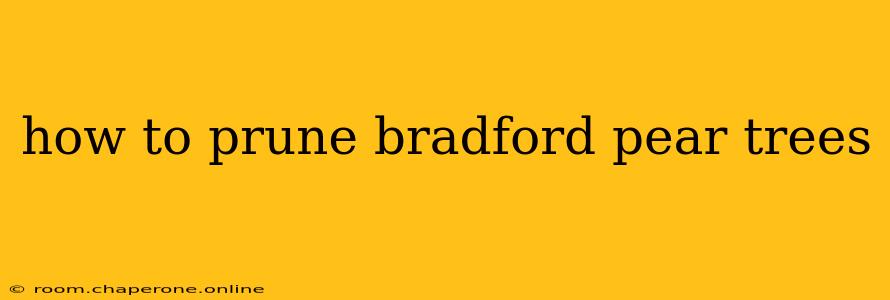Bradford pear trees were once a popular landscaping choice, prized for their stunning spring blossoms. However, their invasive nature and brittle branches have led to a decline in their popularity. If you have a Bradford pear tree on your property, proper pruning is crucial for its health, safety, and to mitigate its negative impact on the environment. This guide will provide you with a comprehensive understanding of how to prune Bradford pear trees effectively and safely.
Understanding Bradford Pear Tree Growth Habits
Before we delve into pruning techniques, it's important to understand the unique growth characteristics of Bradford pear trees. Their vase-shaped structure and rapid growth contribute to several issues:
- Weak Branch Structure: The branches are notoriously brittle and prone to splitting, especially under the weight of ice, snow, or strong winds. This is a significant safety concern.
- Clonal Growth: Bradford pears are sterile cultivars, meaning they don't produce viable seeds. However, they often develop numerous suckers from the base, leading to a messy and overcrowded appearance.
- Invasive Nature: Bradford pears readily hybridize with other pear species, creating invasive offspring that threaten native ecosystems. Pruning can help contain their spread by removing suckers and controlling overall size.
When to Prune Bradford Pear Trees
The best time to prune Bradford pear trees is during late winter or early spring, before new growth begins. This allows the tree to heal properly before the growing season starts. Avoid pruning during the summer months, as this can weaken the tree and make it more susceptible to disease.
Pruning Techniques for Bradford Pear Trees
The goal of pruning a Bradford pear tree is to maintain its structure, remove dead or damaged branches, and control its size. Here's a step-by-step guide:
1. Removing Dead, Damaged, or Diseased Branches
Begin by carefully inspecting the tree and removing any branches that are dead, damaged, diseased, or crossing each other. Use sharp, clean pruning shears or a saw, making clean cuts just outside the branch collar (the slightly swollen area where the branch joins the trunk).
2. Thinning the Canopy
To improve air circulation and sunlight penetration, thin the canopy by selectively removing some of the interior branches. This will reduce the density of the tree and lessen the likelihood of branch breakage. Focus on removing branches that are growing inward or rubbing against each other.
3. Controlling Suckers
Bradford pears often produce numerous suckers from the base of the tree. These suckers should be removed promptly, as they compete with the main tree for resources and contribute to its overall size. Cut them off at their base, ensuring you remove the entire sucker to prevent regrowth.
4. Reducing Overall Size (Optional)
If the tree has become too large, you can reduce its overall size by selectively removing larger branches. However, be cautious when doing this, as heavy pruning can stress the tree. It is generally recommended to reduce the tree's size gradually over several years, rather than attempting to drastically reduce its size in a single pruning session.
5. Maintaining the Vase Shape
Bradford pear trees naturally grow into a vase-shaped form. To maintain this shape, focus your pruning efforts on keeping the central leader(s) relatively short and open. Avoid creating a dense, overcrowded canopy.
Tools You'll Need
- Sharp Pruning Shears: For smaller branches.
- Hand Saw or Pruning Saw: For larger branches.
- Loppers: For medium-sized branches.
- Safety Glasses: To protect your eyes from flying debris.
- Gloves: To protect your hands.
Safety Precautions
- Always wear safety glasses and gloves when pruning.
- Be aware of your surroundings and ensure you have enough space to work safely.
- If you are pruning a large tree or are uncomfortable performing the pruning yourself, consider hiring a certified arborist.
Conclusion
Proper pruning is essential for maintaining the health and safety of a Bradford pear tree. By following these techniques, you can help prevent branch breakage, manage the tree's size, and control its invasive tendencies. Remember, regular maintenance is key to keeping your Bradford pear tree healthy and aesthetically pleasing, while mitigating its negative environmental impact. While these trees are problematic, responsible pruning can help manage their existence within your landscape.

